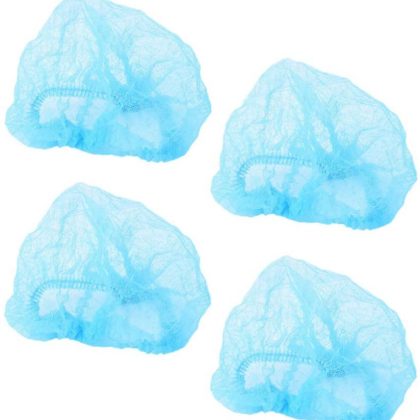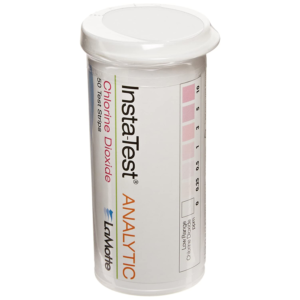- Provides full hair coverage.
- Lightweight and breathable.
- Comfortable, secure fit. Wear all day
-
 Proxy-Clean is a stabilized hydrogen peroxide based product specially formulated to remove and prevent heavy soils in livestock operations of any size. Proxy-Clean utilizes a proprietary stabilizer that is an active ingredient not found in any other product. The stabilizers used in other hydrogen peroxide products just allow them to be shelf stable. Proxy-Clean’s proprietary stabilizer acts as a decomposition catalyst allowing Proxy-Clean to do a complete cleaning on water lines and watering systems. Active IngredientsStabilized Hydrogen peroxide: 50% W/W.
Proxy-Clean is a stabilized hydrogen peroxide based product specially formulated to remove and prevent heavy soils in livestock operations of any size. Proxy-Clean utilizes a proprietary stabilizer that is an active ingredient not found in any other product. The stabilizers used in other hydrogen peroxide products just allow them to be shelf stable. Proxy-Clean’s proprietary stabilizer acts as a decomposition catalyst allowing Proxy-Clean to do a complete cleaning on water lines and watering systems. Active IngredientsStabilized Hydrogen peroxide: 50% W/W.Directions For Use
With Animals Present Mix Proxy-Clean with water to create the following stock solutions:
Discontinue use of any medication, chlorine or sanitizer when administering Proxy Clean. Resume the use of chlorine or other sanitizers after Proxy Clean treatment is finished. For routine sanitation use Proxy Clean at 25-50ppm in the drinking water (use test strips to measure concentration). Between 2 Lots/No Animals Present Fill the water lines with a Proxy Clean/water solution using the following options: Option 1: Use a 1:100 or 1:128 medicator to fill the water lines with a 1% or 0.78% solution of Proxy Clean. Allow the solution to remain in the water lines for a minimum of 48 hours before flushing. Option 2: Use a 3:100 medicator to fill the water lines with a 3% solution of Proxy Clean. Allow the solution to remain in the water lines for a minimum of 12 hours before flushing. When using Proxy Clean make sure that there is an adequate air release from your water system.Pump Water Proxy Clean Days 1 & 2 3 & 4 5 & 6 7-10 1:100 20L 250mL 350mL 475mL 600mL 1:128 20L 320mL 450mL 600mL 775mL Storage & Disposal
Please refer to MSDS sheet.Precautions & First Aid
Please refer to MSDS sheet. MSDS -
 Hydrion Ammonia Test Strips provide a simple and economical means of measuring the ammonia concentration in the environment. These test strips are compliant with local animal welfare programs. Simply wet the strip with some water and wave it in the air. After 10-15 seconds compare the colour of the strip against the colour of the chart.
Hydrion Ammonia Test Strips provide a simple and economical means of measuring the ammonia concentration in the environment. These test strips are compliant with local animal welfare programs. Simply wet the strip with some water and wave it in the air. After 10-15 seconds compare the colour of the strip against the colour of the chart. -
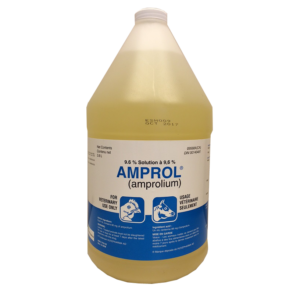 4 or more: $130.99 each This treatment applies to the following species: -Beef Cattle, Chickens, Dairy Cattle DIN 00140481 Veterinary Use Only Active Ingredient: Each mL contains 96 mg of amprolium
4 or more: $130.99 each This treatment applies to the following species: -Beef Cattle, Chickens, Dairy Cattle DIN 00140481 Veterinary Use Only Active Ingredient: Each mL contains 96 mg of amproliumAmprol 9.6% Solution Indications
POULTRY - As an aid in the treatment of caecal coccidiosis in growing chickens and laying birds. CALVES - As an aid in the treatment of coccidiosis caused by Eimeria bovis and E. zuernii in calves.Use Directions
POULTRY - As soon as caecal coccidiosis is diagnosed, give 0.024% amprolium in the drinking water for 5 to 7 days. Continue the treatment with 0.006% amprolium medicated water for an additional one to two weeks. No other source of drinking water should be available to the birds during this time. Use as the sole source of amprolium. CALVES - 0.012% amprolium in drinking water for 5 days. At the usual rate of water consumption, this will provide a daily intake of approximately 10 mg of amprolium per kg of body weight. Give as the sole source of water during the treatment period. NOTE - When one or more calves show signs of coccidiosis, it is likely that the rest of the group have been exposed, and all calves in the group should be treated. MIXING DIRECTIONS: To prepare 200 L of medicated water:DOSAGE MIXING DIRECTIONS 0.0240% Add 500 mL of AMPROL® 9.6% Solution to about 25 L of water in a 200 L medication barrel. Stir, then add water to the 200 L mark. STIR THOROUGHLY. 0.0120% Use same directions as above but use 250 mL of AMPROL® 9.6% Solution. 0.0060% Use same directions as above but use 125 mL of AMPROL® 9.6% Solution. Warnings
Calves - Treated animals must not be slaughtered for use in food for at least 7 days after the latest treatment with this drug.Cautions:
1. POULTRY - If no improvement is noted within 3 days, have the diagnosis reconfirmed and follow the instructions of your veterinarian or poultry pathologist. Losses may result from intercurrent disease or other conditions affecting drug intake which can contribute to the virulence of coccidiosis under field conditions. 2. CALVES - For a satisfactory diagnosis, a microscopic examination of the feces should be done before treatment. When treating outbreaks, drug should be administered promptly after diagnosis is determined. Do not use in calves intended for future breeding.Storage
Protect from freezing. Keep above 5°C. -
 Stalosan F is designed to uniquely meet the hygiene needs of the modern poultry industry. It kills a wide range of pathogens, including bacteria, viruses, fungi, parasites, and flies. Stalosan F also plays an important role in your birds’ environment as a litter conditioner. It is effective in improving air quality and neutralizing harmful substances such as ammonia and hydrogen sulfide. MSDS
Stalosan F is designed to uniquely meet the hygiene needs of the modern poultry industry. It kills a wide range of pathogens, including bacteria, viruses, fungi, parasites, and flies. Stalosan F also plays an important role in your birds’ environment as a litter conditioner. It is effective in improving air quality and neutralizing harmful substances such as ammonia and hydrogen sulfide. MSDS -
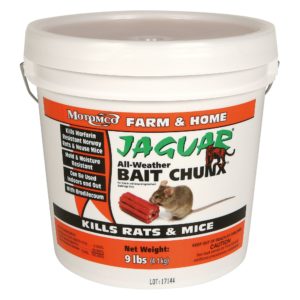 Jaguar All-Weather Bait Chunx contain the active ingredient Brodifacoum, Motomco's most powerful anticoagulant. Motomco's unique, proprietary extrusion process produces Bait Chunx with multiple edges that appeal to a rodent's desire to gnaw. Chunx are made with food-grade ingredients and small amounts of paraffin for a highly palatable bait. Jaguar Chunx are red in color and it's unique shape can be easily placed on rods in a bait station or secured using nails or wire. MSDS
Jaguar All-Weather Bait Chunx contain the active ingredient Brodifacoum, Motomco's most powerful anticoagulant. Motomco's unique, proprietary extrusion process produces Bait Chunx with multiple edges that appeal to a rodent's desire to gnaw. Chunx are made with food-grade ingredients and small amounts of paraffin for a highly palatable bait. Jaguar Chunx are red in color and it's unique shape can be easily placed on rods in a bait station or secured using nails or wire. MSDS -
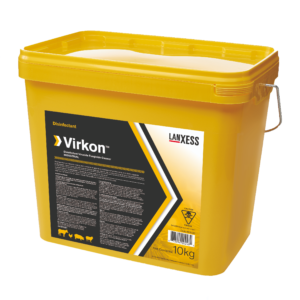 Virkon™ is a disinfectant, possessing wide spectrum virucidal, bactericidal and fungicidal activity. The effectiveness of Virkon™ is further enhanced by its excellent detergent properties, so that clean disease-free surfaces can be achieved. Virkon™ is unique in its composition. Its activity is based on a buffered synergized acid peroxygen system containing a high percentage of surfactant. Virkon™ can be used on all surfaces and in all situations. Once diluted in a 1% solution, Virkon™ is of low toxicity, non-tainting, and non-irritant. Because of its high detergency and mode of action, Virkon™ can be used in an exceptional variety of situations for effective cleaning and virucidal disinfection in a single operation. Virkon™ can be applied manually or through all types of cleaning and spraying equipment. Readily soluble in lukewarm water giving a clear pink solution. Virkon™ consists mainly of inorganic salts. DIN 02125021 Active Ingredients
Virkon™ is a disinfectant, possessing wide spectrum virucidal, bactericidal and fungicidal activity. The effectiveness of Virkon™ is further enhanced by its excellent detergent properties, so that clean disease-free surfaces can be achieved. Virkon™ is unique in its composition. Its activity is based on a buffered synergized acid peroxygen system containing a high percentage of surfactant. Virkon™ can be used on all surfaces and in all situations. Once diluted in a 1% solution, Virkon™ is of low toxicity, non-tainting, and non-irritant. Because of its high detergency and mode of action, Virkon™ can be used in an exceptional variety of situations for effective cleaning and virucidal disinfection in a single operation. Virkon™ can be applied manually or through all types of cleaning and spraying equipment. Readily soluble in lukewarm water giving a clear pink solution. Virkon™ consists mainly of inorganic salts. DIN 02125021 Active IngredientsPotassium monopersulfate 21.4% W/W Directions For Use
In agricultural buildings: animals must be removed from the premise during disinfection. In food processing plants: for food contact surfaces, rinse thoroughly with potable water after disinfection. 1. FOR CLEANING AND DISINFECTION OF SURFACES AND EQUIPMENT: In agricultural buildings Remove all animals from premises. Remove all litter and manure from floors, walls, and other surfaces of barns and equipment. Brush and blow dust from fans, motors, louvers and electrical equipment. For terminal cleaning and disinfection, saturate all surfaces with a 1% w/v solution of Virkon™, using a pressure washer or a fogger. Virkon™ should remain in contact with the surface to be disinfected for at least 10 minutes. Scrub heavily soiled utensils and soak in a 1% w/v solution of Virkon™ for 10 minutes (do not exceed 30 minutes for metal objects). In veterinary hospitals Remove heavy soil deposits then thoroughly wet surfaces to be disinfected with a 1% w/v solution of Virkon™, using a mop, sponge or cloth, as well as by spraying. A minimum contact time of 10 minutes is required. For laboratory equipment and bowls, scrub heavily soiled utensils and soak in a 1% w/v solution of Virkon™ for a minimum of 10 minutes (do not exceed 30 minutes for metal objects). IMPORTANT NOTE: In animal premises where there has been a disease outbreak and/or the mortality/morbidity rates are higher than normal and the causative agent has been determined by a pathology laboratory to be one of those listed in Table 1, the contact time/dilution rate indicated should be used. In food processing plants Remove all debris and other deposits from surfaces. Then, thoroughly wet surfaces to be disinfected with a 1% w/v solution of Virkon™, using a mop, sponge or cloth, as well as by spraying. A minimum contact time of 10 minutes is required. For food contact surfaces, rinse thoroughly with potable water after treatment with Virkon™. For a complete listing of microorganisms against which Virkon™ is effective, refer to the Efficacy Charts 2, 3, and 4. 2. FOR AERIAL DISINFECTION: To replace dangerous and ineffective formalin fumigation in empty farm buildings and veterinary hospitals. Shutdown the ventilation system during the disinfection. Use a mechanical fogging machine as part of terminal disinfection routine with a 1% w/v solution of Virkon™. Apply at a rate of one litre of solution per 100 m3 with particle size not exceeding 70 microns in order to get a minimal contact time of 10 minutes with microorganisms in the air. Leave the room during the fogging. Users and animals may re-enter the treated area once the fog has dispersed. No rinsing is required after fogging. 3. SANITIZING DRINKING WATER SYSTEM: For sanitizing drinking water system at terminal clean out, use a 1.0% w/v solution of Virkon™. Dose header tank and drain system. Wait at least 10 minutes before draining again. DILUTION INSTRUCTIONS1) Select the quantity of disinfectant solution required. 2) Choose appropriate dilution rate. 3) Measure out the amount of Virkon™ indicated using the graduated measuring scoop provided. 4) Add Virkon™ to warm water and stir. There is a 20% loss of activity of 1% solutions of Virkon™ after 14 days in 350 ppm hard water.Dilution rate required (w/v) Quantity of disinfectant solution required 3.0% 2.0% 1.0% 0.5% 0.2% Quantity of Virkon™ required 30 g 20 g 10 g 5 g 2 g 1 Litre 150 g 100 g 50 g 25 g 10 g 5 Litres 300 g 200 g 100 g 50 g 20 g 10 Litres 750 g 500 g 250 g 125 g 50 g 25 Litres Storage
Store between 15°C and 25°C in a dry place in tightly sealed containers.Disposal
1) Rinse the emptied container thoroughly and add the rinsings to treatment site. 2) Follow provincial instructions for any required additional cleaning of the container prior to its disposal. 3) Make the empty container unsuitable for further use. 4) Dispose of the container in accordance with provincial requirements. 5) For information on the disposal of unused, unwanted product and the cleanup of spills, contact the Provincial Regulatory Agency or the Manufacturer.Precautions
Keep out of reach of children. Powder irritating to eyes, skin and mucous membranes. May be harmful if swallowed or inhaled. Do not get powder in eyes. Avoid contact of powder with skin. Handle in such a way as to minimize dust release. Do not mix with other chemicals. When mixing the solution, wear goggles, chemical-resistant gloves, and a mask. It is recommended that workers wear overalls, goggles and a mask when applying Virkon™ solution with a hand-held fogger or a pressure washer.First Aid
Eyes: Irrigate with plenty of water. Skin: When in powder, remove contaminated clothing. Wash with soap and water. Not hazardous when in solution. Ingestion: When in powder, wash mouth with plenty of water. Drink plenty of water. Do not induce vomiting. Seek medical advice. If in solution, rinse mouth out with water. Inhalation: When in powder, if symptoms of coughing, choking, wheezing are troublesome, remove to fresh air and seek medical advice. MSDS -
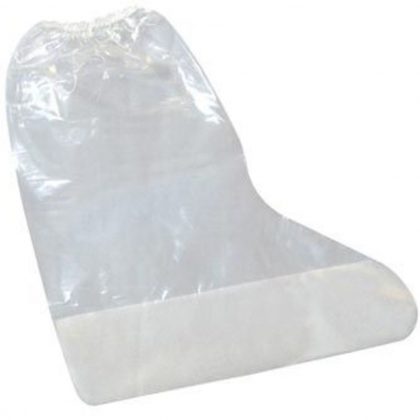 For an outstanding, highly durable elastic-topped boot, the Treader™ line of disposable boots is the way to go. The Treader™ boot’s unique pyramid-shaped treads not only increase wear and durability, they can also be an advantage on slipper surfaces where footing can be precarious. The tread pattern more than triples the thickness of the sole of these disposable boots – the highest wear area and usually the first part of the boot to fail – making Treaders™ one of the most durable boots on the market.
For an outstanding, highly durable elastic-topped boot, the Treader™ line of disposable boots is the way to go. The Treader™ boot’s unique pyramid-shaped treads not only increase wear and durability, they can also be an advantage on slipper surfaces where footing can be precarious. The tread pattern more than triples the thickness of the sole of these disposable boots – the highest wear area and usually the first part of the boot to fail – making Treaders™ one of the most durable boots on the market. -
 Virkon™ is a disinfectant, possessing wide spectrum virucidal, bactericidal and fungicidal activity. The effectiveness of Virkon™ is further enhanced by its excellent detergent properties, so that clean disease-free surfaces can be achieved. Virkon™ is unique in its composition. Its activity is based on a buffered synergized acid peroxygen system containing a high percentage of surfactant. Virkon™ can be used on all surfaces and in all situations. Once diluted in a 1% solution, Virkon™ is of low toxicity, non-tainting, and non-irritant. Because of its high detergency and mode of action, Virkon™ can be used in an exceptional variety of situations for effective cleaning and virucidal disinfection in a single operation. Virkon™ can be applied manually or through all types of cleaning and spraying equipment. Readily soluble in lukewarm water giving a clear pink solution. Virkon™ consists mainly of inorganic salts. DIN 02125021 Active Ingredients
Virkon™ is a disinfectant, possessing wide spectrum virucidal, bactericidal and fungicidal activity. The effectiveness of Virkon™ is further enhanced by its excellent detergent properties, so that clean disease-free surfaces can be achieved. Virkon™ is unique in its composition. Its activity is based on a buffered synergized acid peroxygen system containing a high percentage of surfactant. Virkon™ can be used on all surfaces and in all situations. Once diluted in a 1% solution, Virkon™ is of low toxicity, non-tainting, and non-irritant. Because of its high detergency and mode of action, Virkon™ can be used in an exceptional variety of situations for effective cleaning and virucidal disinfection in a single operation. Virkon™ can be applied manually or through all types of cleaning and spraying equipment. Readily soluble in lukewarm water giving a clear pink solution. Virkon™ consists mainly of inorganic salts. DIN 02125021 Active IngredientsPotassium monopersulfate 21.4% W/W Directions For Use
In agricultural buildings: animals must be removed from the premise during disinfection. In food processing plants: for food contact surfaces, rinse thoroughly with potable water after disinfection. 1. FOR CLEANING AND DISINFECTION OF SURFACES AND EQUIPMENT: In agricultural buildings Remove all animals from premises. Remove all litter and manure from floors, walls, and other surfaces of barns and equipment. Brush and blow dust from fans, motors, louvers and electrical equipment. For terminal cleaning and disinfection, saturate all surfaces with a 1% w/v solution of Virkon™, using a pressure washer or a fogger. Virkon™ should remain in contact with the surface to be disinfected for at least 10 minutes. Scrub heavily soiled utensils and soak in a 1% w/v solution of Virkon™ for 10 minutes (do not exceed 30 minutes for metal objects). In veterinary hospitals Remove heavy soil deposits then thoroughly wet surfaces to be disinfected with a 1% w/v solution of Virkon™, using a mop, sponge or cloth, as well as by spraying. A minimum contact time of 10 minutes is required. For laboratory equipment and bowls, scrub heavily soiled utensils and soak in a 1% w/v solution of Virkon™ for a minimum of 10 minutes (do not exceed 30 minutes for metal objects). IMPORTANT NOTE: In animal premises where there has been a disease outbreak and/or the mortality/morbidity rates are higher than normal and the causative agent has been determined by a pathology laboratory to be one of those listed in Table 1, the contact time/dilution rate indicated should be used. In food processing plants Remove all debris and other deposits from surfaces. Then, thoroughly wet surfaces to be disinfected with a 1% w/v solution of Virkon™, using a mop, sponge or cloth, as well as by spraying. A minimum contact time of 10 minutes is required. For food contact surfaces, rinse thoroughly with potable water after treatment with Virkon™. For a complete listing of microorganisms against which Virkon™ is effective, refer to the Efficacy Charts 2, 3, and 4. 2. FOR AERIAL DISINFECTION: To replace dangerous and ineffective formalin fumigation in empty farm buildings and veterinary hospitals. Shutdown the ventilation system during the disinfection. Use a mechanical fogging machine as part of terminal disinfection routine with a 1% w/v solution of Virkon™. Apply at a rate of one litre of solution per 100 m3 with particle size not exceeding 70 microns in order to get a minimal contact time of 10 minutes with microorganisms in the air. Leave the room during the fogging. Users and animals may re-enter the treated area once the fog has dispersed. No rinsing is required after fogging. 3. SANITIZING DRINKING WATER SYSTEM: For sanitizing drinking water system at terminal clean out, use a 1.0% w/v solution of Virkon™. Dose header tank and drain system. Wait at least 10 minutes before draining again. DILUTION INSTRUCTIONS1) Select the quantity of disinfectant solution required. 2) Choose appropriate dilution rate. 3) Measure out the amount of Virkon™ indicated using the graduated measuring scoop provided. 4) Add Virkon™ to warm water and stir. There is a 20% loss of activity of 1% solutions of Virkon™ after 14 days in 350 ppm hard water.Dilution rate required (w/v) Quantity of disinfectant solution required 3.0% 2.0% 1.0% 0.5% 0.2% Quantity of Virkon™ required 30 g 20 g 10 g 5 g 2 g 1 Litre 150 g 100 g 50 g 25 g 10 g 5 Litres 300 g 200 g 100 g 50 g 20 g 10 Litres 750 g 500 g 250 g 125 g 50 g 25 Litres Storage
Store between 15°C and 25°C in a dry place in tightly sealed containers.Disposal
1) Rinse the emptied container thoroughly and add the rinsings to treatment site. 2) Follow provincial instructions for any required additional cleaning of the container prior to its disposal. 3) Make the empty container unsuitable for further use. 4) Dispose of the container in accordance with provincial requirements. 5) For information on the disposal of unused, unwanted product and the cleanup of spills, contact the Provincial Regulatory Agency or the Manufacturer.Precautions
Keep out of reach of children. Powder irritating to eyes, skin and mucous membranes. May be harmful if swallowed or inhaled. Do not get powder in eyes. Avoid contact of powder with skin. Handle in such a way as to minimize dust release. Do not mix with other chemicals. When mixing the solution, wear goggles, chemical-resistant gloves, and a mask. It is recommended that workers wear overalls, goggles and a mask when applying Virkon™ solution with a hand-held fogger or a pressure washer.First Aid
Eyes: Irrigate with plenty of water. Skin: When in powder, remove contaminated clothing. Wash with soap and water. Not hazardous when in solution. Ingestion: When in powder, wash mouth with plenty of water. Drink plenty of water. Do not induce vomiting. Seek medical advice. If in solution, rinse mouth out with water. Inhalation: When in powder, if symptoms of coughing, choking, wheezing are troublesome, remove to fresh air and seek medical advice. MSDS -
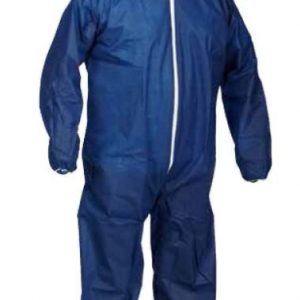 The Polypropylene Disposable Coverall with Hood is a 100% polypropylene, hooded garment featuring a zip front and elastic at the wrist, ankle, and hood. It is an extremely lightweight, and breathable option, perfect for protection against dirt, grease, and grime in non-hazardous settings.
The Polypropylene Disposable Coverall with Hood is a 100% polypropylene, hooded garment featuring a zip front and elastic at the wrist, ankle, and hood. It is an extremely lightweight, and breathable option, perfect for protection against dirt, grease, and grime in non-hazardous settings.- 100% Polypropylene
- Hooded
- Zip front
- Elastic at wrist, ankle and hood
- Low-cost disposable garment that protects from dirt, grease and grime. Extremely lightweight and breathable. Ideal for non- hazardous work environments
- Available in Navy Blue
- Available in Large, XL, XXL, XXXL
-
 Klo Pro is a unique chlorine dioxide solution in which both components are in liquid form, other chlorine dioxide products are often offered in powdered or tablet form only. These tablets or powders can be difficult to dissolve and often depend on several factors including water temperature and water quality to ensure an even mixture with no sediment or precipitate. Klo Pro is already in liquid form and provides a uniform mixture for every application without having to worry about the formation of a precipitate. Klo Pro is easily activated by simply pouring the activator bottle into the Klo Pro pail. Unlike other ClO2 products there is no need to mix the products in a third container. Unlike chlorine, chlorine-dioxide remains active over a broad range of pH. When using conventional chlorine the pH of the water must be neutral or slightly acidic (pH<7). Producers who choose to use conventional chlorine are often burdened with the additional cost of adding an acidifier. Chlorine dioxide is up to 10 times more soluble in water when compared to conventional chlorine and requires approx. Only 10% of the concentration of conventional chlorine to produce the same disinfecting efficacy. Suggested dose rate is 0.5 - 1ppm ClO2 for routine livestock drinking water sanitation. Mixing Directions
Klo Pro is a unique chlorine dioxide solution in which both components are in liquid form, other chlorine dioxide products are often offered in powdered or tablet form only. These tablets or powders can be difficult to dissolve and often depend on several factors including water temperature and water quality to ensure an even mixture with no sediment or precipitate. Klo Pro is already in liquid form and provides a uniform mixture for every application without having to worry about the formation of a precipitate. Klo Pro is easily activated by simply pouring the activator bottle into the Klo Pro pail. Unlike other ClO2 products there is no need to mix the products in a third container. Unlike chlorine, chlorine-dioxide remains active over a broad range of pH. When using conventional chlorine the pH of the water must be neutral or slightly acidic (pH<7). Producers who choose to use conventional chlorine are often burdened with the additional cost of adding an acidifier. Chlorine dioxide is up to 10 times more soluble in water when compared to conventional chlorine and requires approx. Only 10% of the concentration of conventional chlorine to produce the same disinfecting efficacy. Suggested dose rate is 0.5 - 1ppm ClO2 for routine livestock drinking water sanitation. Mixing Directions -
 Credo is a premise spray for the control of darkling beetles (lesser meal worms) in poultry facilities.Credo MSDS
Credo is a premise spray for the control of darkling beetles (lesser meal worms) in poultry facilities.Credo MSDSGUARANTEE: Imidacloprid 526g/L Directions For Use:
Mix 90 mL in 2 – 7.5 L of water per 100m2. Use sufficient water to obtain a mixture that will provide effective coverage of surfaces but not require excessive drying time. Apply after clean out and before new birds are introduced to the house. Treat all areas where beetles are located, such as under feed/water lines, the lower section of walls, support beams and in cracks and crevices. The level of infestation will determine whether using a band application or treating the whole poultry house is required. Always read and follow complete instructions on the product label before use. Do not apply when birds are present. Apply between flocks following de-caking/sanitation. DO NOT enter or allow worker entry into treated areas until sprays have dried. Allow treated surfaces to dry before restocking/reintroducing birds into the facility. Refer to label for complete list of instructions.Environmental Hazards
This product is highly toxic to aquatic invertebrates. Keep out of lakes, streams, ponds or other aquatic systems. Do not contaminate water when disposing of equipment wash waters. This product is highly toxic to bees exposed to direct treatment or residues on blooming crops or weeds. Do not apply this product or allow it to drift to blooming crops or weeds if bees are visiting the treatment area. This product is toxic to birds. Apply this product only in accordance with the label.First Aid
Take the container, label or product name and Pest Control Product Registration Number with you when seeking medical attention. IF SWALLOWED: Call a poison control centre or doctor immediately for treatment advice. Have person sip a glass of water if able to swallow. Do not induce vomiting unless told to do so by the poison control centre or doctor. Do not give anything by mouth to an unconscious person. IF IN EYES: Hold eye open and rinse slowly and gently with water for 15-20 minutes. Remove contact lenses, if present, after the first 5 minutes, then continue rinsing eye. Call a poison control centre or doctor for treatment advice. IF ON SKIN OR CLOTHING: Take off contaminated clothing. Rinse skin immediately with plenty of soap and water for 15-20 minutes. Call a poison control centre or doctor for treatment advice. IF INHALED: Move person to fresh air. If person is not breathing, call 911 or an ambulance, then give artificial respiration, preferably by mouth to mouth if possible. Call a poison control centre or doctor for treatment advice. TOXICOLOGICAL INFORMATION: No specific antidote is available. Treat symptomatically.Storage And Disposal
Store in a cool, dry place and in such a manner as to prevent cross contamination with other pesticides, fertilizers, food, and feed. Store in original container and out of the reach of children, preferably in a locked storage area. Do not contaminate water, food or feed by storage or disposal. Store in a cool, dry secured storage area. Do not store this product under wet conditions. For information on disposal of unused, unwanted product, contact the manufacturer or the provincial regulatory agency. Contact the manufacturer and the provincial regulatory agency in case of a spill, and for clean-up of spills. -
 pH test strips are simple yet effective tools for measuring the acidity or alkalinity of a solution. They consist of small strips of plastic with indicators that change color in response to variations in pH. When dipped into a liquid, the strip changes color according to the solution’s pH level, allowing you to quickly and easily determine the pH of the water.
pH test strips are simple yet effective tools for measuring the acidity or alkalinity of a solution. They consist of small strips of plastic with indicators that change color in response to variations in pH. When dipped into a liquid, the strip changes color according to the solution’s pH level, allowing you to quickly and easily determine the pH of the water.- 100 single-use strips conveniently packed into a moisture-wicking flip-up vial
- Vivid color chart printed on the bottle enables easy determination of pH with increments of 1
- Plastic Strips enable you to test a solution without the risk of touching the solution and eliminating the risk of finger staining
-
 These Low-level Peroxide Test Strips are used to identify remaining peroxides in water that has been treated with peroxide as a disinfectant. These test strips deliver quick results in seconds and are calibrated to 0, 1, 3, 10, 50, and 100 ppm for accurate readings.
These Low-level Peroxide Test Strips are used to identify remaining peroxides in water that has been treated with peroxide as a disinfectant. These test strips deliver quick results in seconds and are calibrated to 0, 1, 3, 10, 50, and 100 ppm for accurate readings.- The strips are designed for user convenience, requiring no additional equipment and providing results within seconds.
- The Peroxide Test Strip will turn a progressively darker shade of blue depending on the concentration of peroxide in the mixture.
- Obtain straightforward measurements at 0, 1, 3, 10, 50, and 100 ppm.
-
 For control of the lesser mealworm (the darkling beetles Alphitobius diaperinus) and other listed pests ACTIVE INGREDIENT: Tetrachlorvinphos - 50% w/w In case of spills, poisoning or fire, call your provincial emergency response line.
For control of the lesser mealworm (the darkling beetles Alphitobius diaperinus) and other listed pests ACTIVE INGREDIENT: Tetrachlorvinphos - 50% w/w In case of spills, poisoning or fire, call your provincial emergency response line.DIRECTIONS FOR USE
Use Debantic 50WP as part of an overall integrated pest management (IPM) program. Debantic 50WP Insecticide Poultry and Livestock Premise Spray is suitable for use in conventional power or low pressure knapsack sprayers. Agitation is recommended to prevent undue settling of the suspension. Follow the USE DIRECTIONS for the proper percent solution needed for a specific insect and areas or types of wall surfaces. Refer to DILUTION TABLE for the quantity of insecticide needed to make the percent solution recommended. PREMISES USE DIRECTIONSPOULTRY USE DIRECTIONS (DO NOT APPLY TO RESIDENCES)INSECT PROBLEM AREAS % SOLUTION REMARKS Flies Dairy barns, poultry houses, swine barns, other animal buildings. 2.0% For dry whitewashed wood or concrete block surfaces, apply 8 litres of solution/100 sq. m. 1.0% For unpainted wood or painted concrete block surfaces, apply 8 litres of solution/100 sq. m. 1.0% For masonite or galvanized sheet metal surfaces, apply 4 litres of solution/100 sq. m. Maggots Poultry droppings, manure piles, garbage piles, under feed troughs 1.0% Apply 4 litres of solution/10 sq. m. Penetrate problem area first time - repeat every 7-10 days thereafter. DILUTION TABLEINSECT TYPE OF HOUSING % SOLUTION REMARKS Lice & Mites Wire Cages 0.5% Apply directly to birds (4 litres/100 birds). Spray vent and fluff areas from below. Repeat when necessary. Do not repeat more often than every 14 days. For individual bird treatment, apply 30 mL of the mixture per bird. NOTE: For maximum lasting control of the northern fowl mite, penetration of the feathers around the vent area is essential. Use power sprayer at 7-9 kg/sq cm at no less than recommended pressure. More attention must be given to each individual bird when using low-pressure equipment. Treat roosters carefully and thoroughly to avoid re-infestation in breeding flocks. Floor Management Dust Box 50% WP Mix evenly throughout top layer of box contents using 150 g/100 birds. Lice, Mite & Larvae and adults of the lesser mealworm (the darkling beetle, Alphitobius diaperinus) Floor Management Roost Paint 1.0% Treat with brush or spray thoroughly, particularly cracks and crevices using 145-165 mL/10 m. Floor Management Litter 1.0% Apply 1-4 litres/100 sq. m. evenly for penetration to litter surface. Also apply thoroughly to walls, roost, cracks, crevices and interiors. Spray birds lightly. Floor Management Litter 50% WP Treat evenly and thoroughly using 75 g/10 sq. m. Use a rotary or mechanical duster. (Wear dust mask during this operation). Fowl Tick All Types 1.0% Apply 3-4 litres/10 sq. m. thoroughly to walls, ceilings, floor cracks and crevices with a power sprayer. PRECAUTIONS KEEP OUT OF REACH OF CHILDREN AND LIVESTOCK. Harmful if swallowed or absorbed through skin. Avoid breathing spray mist and dust. Do not get in eyes, on skin, or on clothing. Wash thoroughly with soap and water after handling and before eating or smoking. Avoid contamination of feed and foodstuffs. Store apart from food and feed in a cool place. This product is toxic to fish. Do not contaminate water by disposal of this product. Do not re-use empty container. FIRST AID IF SWALLOWED: Call a poison control centre or doctor immediately for treatment advice. Have person sip a glass of water if able to swallow. Do not induce vomiting unless told to do so by a poison control centre or doctor. Do not give anything by mouth to an unconscious person. IF INHALED: Move person to fresh air. If person is not breathing, call 911 or an ambulance, then give artificial respiration, preferably by mouth-to-mouth, if possible. Call a poison control centre or doctor for further treatment advice. IF ON SKIN OR CLOTHING: Take off contaminated clothing. Rinse skin immediately with plenty of water for 15-20 minutes. Call a poison control centre or doctor for treatment advice. IF IN EYES: Hold eye open and rinse slowly and gently with water for 15-20 minutes. Remove contact lenses if present, after the first 5 minutes, then continue rinsing eye. Call a poison control centre or doctor for treatment advice. Take container, label or product name and Pest Control Product Registration Number with you when seeking medical attention. TOXICOLOGICAL INFORMATION Tetrachlorvinphos is a cholinesterase inhibitor. Typical symptoms of overexposure to cholinesterase inhibitors include headache, nausea, dizziness, sweating, salivation, runny nose and eyes. This may progress to muscle twitching, weakness, tremor, incoordination, vomiting, abdominal cramps and diarrhea in more serious poisonings. A life-threatening poisoning is signified by loss of consciousness, incontinence, convulsions and respiratory depression with a secondary cardiovascular component. Treat symptomatically. If exposed, plasma and red blood cell cholinesterase tests may indicate degree of exposure (baseline data are useful). Atropine, only by injection, is the preferable antidote. Oximes, such as Pralidoxime Chloride, may be therapeutic if used early; however, use only in conjunction with atropine. In cases of severe acute poisoning, use antidotes immediately after establishing an open airway and respiration. With oral exposure, the decision of whether to induce vomiting or not should be made by an attending physician. DISPOSAL 1. Triple-or pressure-rinse the empty container. Add the rinsings to the spray mixture in the tank. 2. Follow provincial instruction for any required additional cleaning of the container prior to its disposal. 3. Make the empty container unsuitable for further use. 4. Dispose of the container in accordance with provincial requirements. 5. For information on disposal of unused, unwanted product, contact the manufacturer or the provincial regulatory agency. Contact the manufacturer and the provincial regulatory agency in case of a spill and for clean-up of spills. MSDSAMOUNT (kg) OF 50% WETTABLE POWDER AMOUNT OF WATER 0.5% SOLUTION 1% SOLUTION 2% SOLUTION 1/4 kg 25 litres 12 1/2 litres 6 1/4 litres 1 100 litres 50 litres 25 litres 2 200 litres 100 litres 50 litres 4 400 litres 200 litres 100 litres

